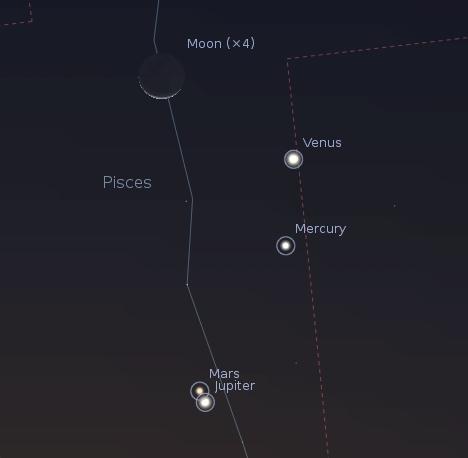 SkyCaramba astronomy blog for the week ending May 7, 2011.
SkyCaramba astronomy blog for the week ending May 7, 2011.
Four planets engage in a dance at dawn this month. Venus, Mercury, Jupiter, and Mars will come within six degrees of each other. Some of them, taken by twos, will be much closer. Jupiter and Mars start the month just 0.4 degrees apart.
People watching from low latitudes are already enjoying a lineup. They will continue to get the best views. The planets will be in the sky the most time before sunrise there. Wherever you are, it’s best to find a clear horizon. Houses and trees will often be in the way. Free programs like Stellarium enable you to preview the sky for any time or location on Earth before going outside yourself to identify the planets.
For people interested in planetary alignments, this should be about as interesting as the four planets (Mars, Saturn, Venus, and Mercury) together in the evening skies last August spanning 22 degrees. Although spread farther apart, that lineup was easier to see.
If the apparent closeness of the heavenly bodies intrigues you, recall that in May 2000, five planets (Mars, Saturn, Jupiter, Mercury, and Venus) and the sun were in a group spanning no more than about 25 degrees. You couldn’t see all five of those planets at the same time though, because some of them were on the morning side of the sun and some were on the evening side.
Talk about a planetary alignment and a few people feel obligated to talk about the end of the world. I don’t get that. There have been far more spectacular alignments than this month’s and the world is still here. February 4, 1962 must have been a really awesome day to be alive. Not only were five planets, the moon, and the sun within 17 degrees, people in Indonesia and on a long line in the Pacific got a total solar eclipse! A few doomsayers surely thought the 5th was an even more awesome day to be alive.
Back to our present happening. Don’t worry about gravitational stresses ripping Earth apart this month. The moon is in the best position to cause that and it hasn’t yet. If you’re on or near an ocean, you may be affected by the tides. But that happens every day. The sun is always about 93 million miles away, and its almost perfectly constant gravitational influence on Earth isn’t usurped by any of the other objects going around it.
Tiny Mercury will be more than 83 million miles from us. Venus will be about 138 million miles away. To Mars is more than 213 million miles. And Jupiter, massive as it is, can’t tug on us much from a distance of more than 538 million miles.
Those objects are so far away, our depth perception doesn’t work on them. But if there’s a lot of buzz about what’s happening in the morning sky this month, you’ll know we just happen to be in the right place at the right time to enjoy the view.